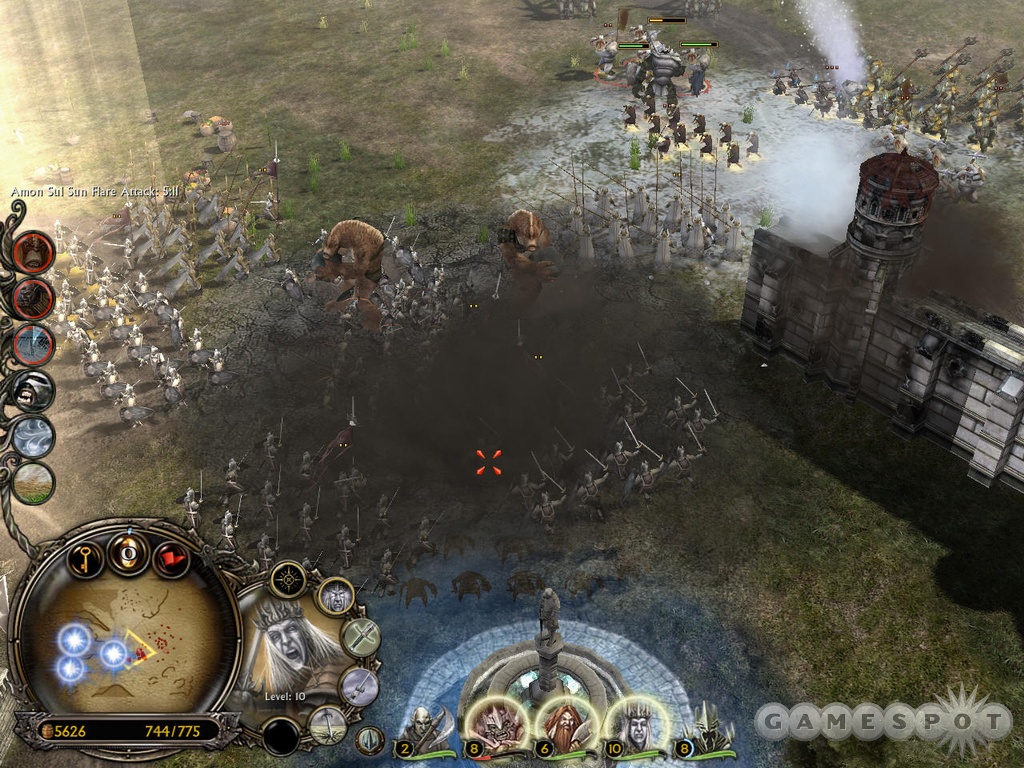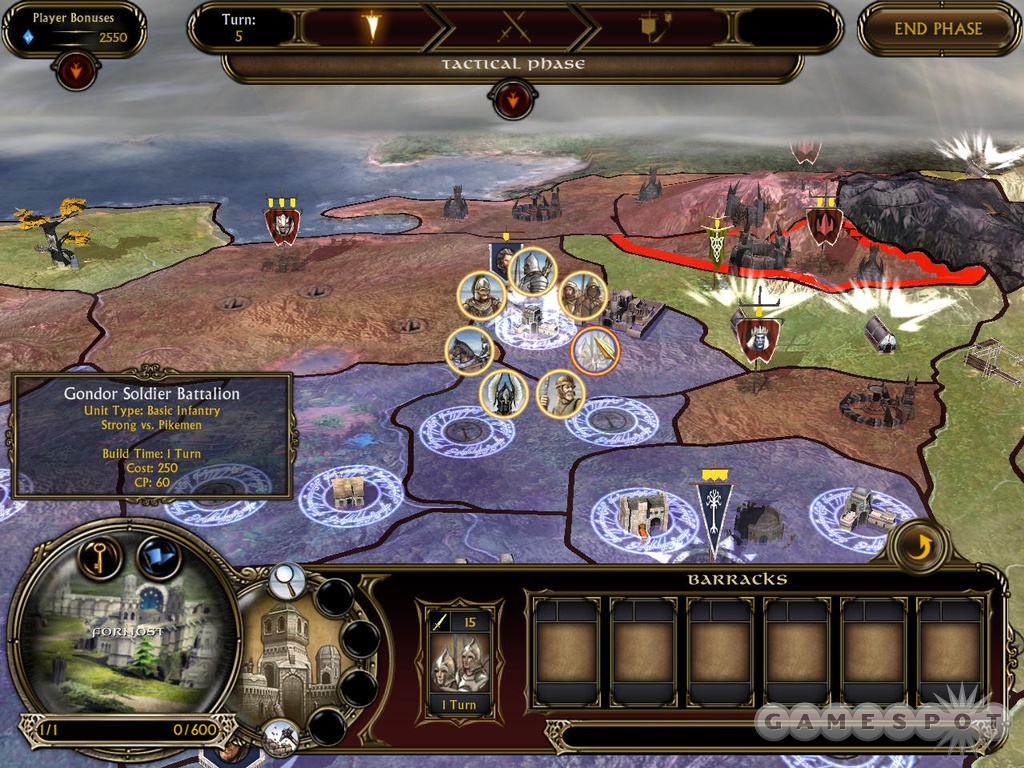The Lord of the Rings, The Battle for Middle-earth II, The Rise of the Witch-King Hands-On
This upcoming expansion to The Battle for Middle-earth II will let you battle as an evil faction centuries before Frodo, Aragorn, and all the rest.
The Lord of the Rings, The Battle for Middle-earth II, The Rise of the Witch-King may very well win awards for the longest title in years, but EA hopes that it's the gameplay in this real-time strategy expansion that will garner your attention. Building on the foundation laid by this year's The Battle for Middle-earth II, Rise of the Witch-King could be thought of as a prequel to the events seen in The Lord of the Rings movies and novels. Instead of giving you command of Frodo, Aragorn, and the armies of Gondor, Rohan, or Mordor, the expansion will give you command of an ancient evil faction that is commanded by the Witch-King, the head Nazgul in the movies. We've been playing around with a fairly complete version of Rise of the Witch-King to see how it all fits together before the game's release.
Because most of the ground in Peter Jackson's acclaimed movie trilogy has already been covered, and because EA has the complete J.R.R. Tolkien license, Rise of the Witch-King does something unexpected. Instead of giving us another angle of the events in The Lord of the Rings, the expansion is set thousands of years prior to the movies. If you saw The Fellowship of the Ring, you'll recall the massive battle that opens the movie and sets the stage for all of the events to follow. The dark lord, Sauron, is defeated. Although his One Ring is recovered by Isildur, the ring is lost again after Isildur is killed. Rise of the Witch-King is set years after that event as the Witch-King, Sauron's fearsome lieutenant, must once again rally the forces of evil by establishing a new kingdom in the lands of Angmar. The Witch-King must also wage war against the kingdom of Arnor, which is home to the ancestors of Aragorn.

The most notable new addition in the expansion is the new Angmar faction, which consists of lots of powerful new units. The Angmar have two different types of trolls (hill trolls are used for countering cavalry, while snow trolls are good for everything else), dire wolves, Black Numenoreans (a human infantry unit), Dark Dunedain (a human archer unit), among others. Perhaps the most versatile unit is thrall master. The thrall master is a single unit, but it can summon a battalion of warriors, wolf-riders, spearmen, or axe throwers and then serve as the battalion leader. However, if the thrall master is killed, his battalion will be thrown into chaos. Another interesting new unit is the sorcerer, which is always escorted by acolytes. The sorcerer uses the acolytes to power his spells, so the more powerful the spell, the more acolytes the sorcerer must sacrifice. Angmar heroes include the Witch-King (of course), as well as a bunch of new faces that we've never seen before. There's Rhogash, a troll hero; Hwaldar, a tribal chieftain; and the Whisperer, a corrupted soul that serves the Witch-King.
The existing factions from Battle for Middle-earth II also get new units to even things out with the new faction. The most notable of these are the new minihorde units, which are sort of like heroes in the way they have special powers and can level up, except that they come in groups. So the Men of the West get the knights of Dol Amroth, the elves get Noldor Warriors, Mordor gets black riders, and so on. There are also improved siege weapons for the factions, because one of the goals in the game is to make sieges more significant.
In terms of gameplay, the Angmar faction was designed to be the evil equivalent to the dwarves, and the faction plays pretty much the same as the other factions. An example of this can be seen with resource generation. The Angmar rely on mills, which are equivalent to the mines and farms used for the other factions. Basically, each mill has a radius around it, and if you can build a mill in an empty area, it will work at 100 percent capacity. However, if you cluster your mills too tightly, or the terrain isn't perfectly flat, you will impact the efficiency of the mills. This resource system requires you to expand quickly, which makes it harder to sit behind defenses and wait for your strength to build.
When it comes to battles, the Angmar units are powerful, but they're comparable to the units from the other factions, which makes sense for balance purposes. Still, watching Angmar trolls wade into battle is an impressive sight. The Angmar special powers are also pretty cool. Depending on which powers you unlock, you can summon giants to the battlefield, suck up all the enemy forces in a powerful vortex of wind and them dump them on the ground, or drop a freezing rain on the land to strip enemy units of their leadership bonuses.

The War of the Ring persistent campaign returns improved and enhanced in the expansion. In War of the Ring, you select a faction and then must try to conquer all of Middle-earth. The challenge is that you must balance the turn-based strategic view with the real-time battles. So you can build up a huge army in one province, move it into another province on the strategic map to invade it, and then settle the battle in real time--or you can let the computer automatically generate the results of the fight. The major improvements are geared toward adding more persistence to this mode. One of the weaknesses in the original War of the Ring campaign was that you could build a huge army in one battle, but then it would instantly disappear when you returned to the strategic map. That has now changed because you can now transfer armies from a battle to the strategic map. Keep in mind that these units have upkeep costs, so you will have a limit to the number of armies you can transfer.
With its unique setting, The Rise of the Witch-King should provide Tolkien fans an opportunity to explore an era that has not really been seen or covered in any of the novels or movies. And the expansion looks to add a fair amount of content to the core game. Everything at this stage looks almost complete, and the work-in-progress version of the game that we played was very polished. The expansion should ship later this month.
Got a news tip or want to contact us directly? Email news@gamespot.com
Join the conversation